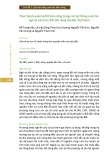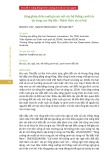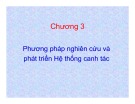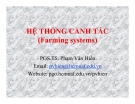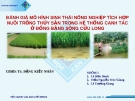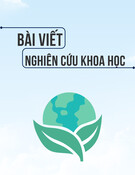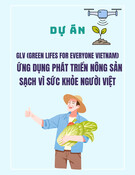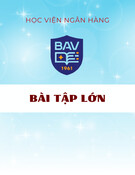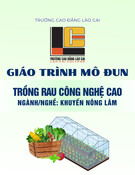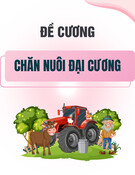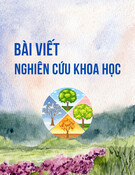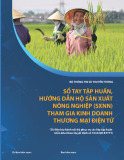
NGHIÊN CỨU HỆ THỐNG CANH TÁC LÚA - ẾCH
NHẰM HẠN CHẾ MỘT SỐ CÔN TRÙNG GÂY HẠI
VÀ NÂNG CAO THU NHẬP Ở VÙNG ĐỒNG BẰNG SÔNG HỒNG
Tạ Minh Sơn, guyễn Thế Yên
SUMMARY
Research Rice -Frog Farming System to Minimize some Damaging Insects and
Enhance Income for Farmers in Red River Delta (RRD)
Monoculture rice farming is a common form in the Red River Delta (RRD). This
farming has created favorable conditions for the development of many types of insect and
diseases, THEREBY causing loss of crops. To ensure the rice productivity, farmers have to
use large amounts of plant protection chemicals. This not only increases production costs
but also causes negative impact on the environment and ecological imbalance of paddy
field. Results from experiments in 2007-2009 indicated that Thai hybrid frogs had highest
yield and P6 rice variety is most suitable for the farming systems. A rice cultivation
technique “border effect” by changing in distance between row and rice plants has
created a favorable condition for the development of frogs. Results from experiments of
four rice plant on P6 rice variety showed that D2 density of 40 hills/m
2
(12 cm by 25 cm) is
best for frogs walking and jumping to catch prey, and rice yield of 5.4-5.8 tons/ha/spring
and 4.8-5.2 tons/ha/summer crop season. Results from experiments of three frog densities:
(2,700; 5,400 and 8,100 frogs/ha) showed that the density of 10,000 frogs/ha had high
effect and suited for the intensive farming conditions of farmers. The bigger the released
frogs the shorter the time to, but economic efficiency is highest when the released frogs
quantity 40-50g/frog. Results also showed that paddy field with released frogs reduced
about 2-3 times of pesticide sprays during the time from till ring to panicle differentiation.
Using pesticides namely as Regent 800WG, Virtako, Trione and Validacine did not affect
the growth and development of frogs in rice fields. Results of testing models in Hai Phong
(1ha) and Hai Duong in summer crop season in 2009 showed a total income from one rice
and one frog harvesting season was from 99.4 to 108.6 million VD/ha/crop season. et
interest income was 37.2 to 43.6 million VD/ha/crop season. From these results, we
suggested that rice-frog farming systems for high rice yield, reduce cost of plant protection
chemicals, increase farmer's income and create ecological balance.
Keywords: Rice, Frog, System, Farming, Cultivation, Insects; Income.

I. ĐẶT VẤN ĐỀ
Trồng lúa độc canh ở vùng ĐBSH là
điều kiện thuận lợi cho sâu bệnh phát
triển gây tổn thất mùa màng và tác động
xấu đến môi trường, năng suất lúa đã đạt
ở mức tương đối cao song hiệu quả kinh
tế của sản xuất lúa vẫn còn rất thấp, tổng
thu nhập từ hai vụ lúa chỉ đạt 25-30 triệu
đồng/ha/năm (thống kê năm 2007-2008).
Hệ sinh thái ruộng lúa là môi trường cho
ếch và côn trùng hại lúa tồn tại - ếch là
thiên địch côn trùng hại lúa - làm tăng
năng suất; quan hệ lúa ếch trong hệ sinh
thái ruộng lúa là quan hệ thân thiện và
cho hiệu quả kinh tế cao. Nội dung bài
này là kết quả nghiên cứu hệ thống canh
tác lúa - ếch do Viện Cây lương thực và
Cây thực phNm thực hiện.
II. VẬT LIỆU VÀ PHƯƠN G PHÁP
N GHIÊN CỨU
1. Vật liệu nghiên cứu
- Thí nghiệm sử dụng 3 chi ếch: Ếch bò
Bắc Mỹ (Rana catesbeina); ếch đồng Thái
Lan (Rana rugolosa); ếch lai Thái Lan (ếch
bò Bắc Mỹ × ếch đồng Thái Lan).
- Thí nghiệm sử dụng 3 giống lúa: P6;
Thục Hưng 6 và AC5.
2. Phương pháp nghiên cứu
1. Các thí nghiệm khảo sát giống và các
biện pháp kỹ thuật (mật độ thả ếch, cấy
lúa..) được bố trí theo khối ngẫu nhiên hoàn
chỉnh (RCBD) với 3 lần nhắc.
2. Nuôi thả và giữ ếch trong ruộng lúa
bằng các phương pháp quây nilon, lưới.
- Thời gian gieo mạ vụ xuân ngày 10-
15/1, cấy khi mạ 4 lá; vụ mùa 20-25/6 cấy
mạ 20 ngày tuổi. Thời gian thả ếch vụ
xuân: Sau khi cấy 30-40 ngày; vụ mùa: Sau
khi cấy 25-30 ngày.
- Phân bón cho lúa: N:P:K:
200:300:150 kg/ha trên nền phân chuồng 10
tấn + 216 kg đạm urê + 540 kg lân Lâm Thao
+ 162 kg kali/ha.
- Mật độ cấy: D1: 45 khóm/m
2
(12×15;12×20 cm); D2: 40 khóm/m
2
(12×15;12×25 cm); D3: 35 khóm/m
2
(12×15; 12×30 cm); đối chứng cấy 50
khóm/m
2
(12 cm×15 cm). Áp dụng cấy theo
hiệu ứng hàng biên.
+ Phun thuốc hoá học phòng trừ sâu
bệnh trong ruộng lúa thả ếch: Thuốc trừ
bệnh: Validacine; Ditacine; Thuốc trừ sâu:
Thử nghiệm với 5 công thức phun: CT1:
Regent 800WG; CT2: Padan + Sherpa;
CT3: Satrungdan + Sherpa; CT4:
Satrungdan + Regent; CT5: Virtako +
Validacine + (vụ mùa) + Trione (vụ xuân) +
Ditacine.
+ Thức ăn cho ếch: Cám tổng hợp
CARGILL; tính cho ếch theo từng giai đoạn.
3. Đánh giá hiệu quả kinh tế của mô
hình canh tác cấy lúa - ếch bằng phương
pháp CIMMYT, 1988. Sử dụng chỉ tiêu tỷ
suất lợi nhuận MBCR (Marginal Benefit
Cost Ratio) để đánh giá hiệu quả kinh tế
của mô hình sản xuất mới và mô hình sản
xuất cũ.

Hệ số MBCR =
Tổng thu mô hình mới - Tổng thu mô hình cũ
Tổng chi mô hình mới - Tổng chi mô hình cũ
4. Số liệu được xử lý theo chương trình
Excel, GenStat 8.
III. KẾT QUẢ VÀ THẢO LUẬN
1. So sánh, tuyển chọn một số chi ếch
(genus) và một số giống lúa trong hệ
thống canh tác lúa - ếch, tại Viện Cây
lương thực và Cây thực ph9m
1.1. Kết quả tuyển chọn chi ếch, tại Viện
CLT - CTP
Khảo sát 3 chi ếch: Ếch bò Bắc Mỹ, ếch
đồng Thái Lan và ếch lai Thái Lan (được
lai từ giống ếch bò Bắc Mỹ với giống ếch
đồng Thái Lan), kết quả nghiên cứu đã xác
định: Ếch lai Thái Lan nhanh lớn cho năng
suất cao đạt 5,17 tạ/ha cao nhất trong 3 chi
ếch thử nghiệm phù hợp nhất với hệ thống
canh tác lúa - ếch.
1.2. Kết quả tuyển chọn giống lúa, tại Viện
CLT - CTP
Tiến hành khảo sát 3 giống lúa P6,
AC5, TH6 với mật độ cấy D2: 40 khóm/m
2
(12 cm×22 cm); (12 cm×25 cm), mật độ
ếch 100con/100m
2
. Kết quả cho thấy năng
suất giống TH6 (Thục Hưng 6) là cao nhất
đạt 49,8 tạ/ha tiếp đến là giống P6 đạt 47,8
tạ/ha, sau cùng là giống AC5 cho năng suất
41,4 tạ/ha. hận xét chung về các mặt thì
giống P6 phù hợp nhất với hệ thống canh
tác lúa - ếch cả thời gian sinh trưởng (dài
nhất 130 ngày) - thích hợp với thời gian
nuôi ếch cho năng suất cao.
2. :ghiên cứu biện pháp kỹ thuật trong
hệ thống canh tác lúa - ếch, tại Viện CLT
- CTP
2.1. Kết quả nghiên cứu mật độ và khoảng
cách trong phương pháp cấy "hiệu ứng
hàng biên" trong hệ thống canh tác lúa - ếch
- Năng suất ếch thu được trong vụ xuân
ở mật độ D2 đạt cao nhất 5,5 tạ/ha và trong
vụ mùa ở D3 thu được cao nhất 6,0 tạ/ha
(bảng 1). Kết quả nghiên cứu biện pháp kỹ
thuật về các công thức khoảng cách cấy
phù hợp tạo điều kiện thuận lợi nhất cho
ếch di chuyển, bắt mồi, tìm kiếm thức ăn
tĩnh, trú ngụ jn nấp. Trong 3 công thức
khoảng cách áp dụng cho cấy lúa thả ếch,
công thức D2 (12× 15 cm; 12 × 25 cm) cho
ruộng lúa thả ếch là thích hợp nhất cho ếch
sinh trưởng và phát triển trong ruộng lúa.
Bảng 1. Một số yếu tố cấu thành năng suất lúa, năng suất ếch và năng suất lúa P6 trong vụ
xuân năm 2007-2008, tại Viện Cây lương thực và Cây thực phjm
Chỉ tiêu
Mật độ
(%) bông
bạc/khóm
Số bông/khóm
(bông)
Số hạt/bông
(hạt)
Năng suất ếch
(tạ/ha)
Năng suất lúa
(tạ/ha)
Xuân Mùa Xuân Mùa Xuân Mùa Xuân Mùa Xuân Mùa
KC1(D1) 11,4 12,0 8,1 6,7 122,2 118,1 4,1 4,9 56,20 49,67
KC2(D2) 9,6 9,3 8,6 8,1 123,3 119,5 5,5 5,6 55,67 49,00
KC3(D3) 10,2 9,7 9,3 8,8 123,9 120,4 4,5 6,0 54,43 48,00
KC4(đ/c) 11,2 12,5 7,9 6,8 121,0 117,8 3,1 3,6 57,77 51,33
LSD.05 7,07 5,93
CV(%) 6,7 6,4

2.2. Kết quả nghiên cứu mật độ ếch thả
trong hệ thống canh tác lúa - ếch, tại Viện
CLT - CTP
Khảo sát 3 mật độ ếch lai Thái Lan (vụ
mùa năm 2007: 30; 50; 70 con/100m
2
; vụ
mùa năm 2008: 70; 100; 130 con/100m
2
)
trên lúa P6 tại Viện Cây lương thực và Cây
thực phNm, kết quả trong vụ mùa 2007, ở
mật độ thả 70 con/100m
2
tỷ lệ bông bạc
thấp nhất (10,8%) trong khi đó ruộng không
thả tỷ lệ này là 13%. Năng suất lúa (đạt
47,53 tạ/ha) và năng suất ếch cao nhất (đạt
8,73 tạ/ha). Ở ruộng không thả năng suất
lúa đạt 48,1 tạ/ha, ô thả 30 con/100m
2
năng
suất ếch đạt 4,53 tạ/ha (bảng 2).
Vụ mùa năm 2008 cho thấy: Số ếch thu
hoạch ở các ô thí nghiệm đạt từ 75-85%.
Năng suất ếch: Ở ô thả mật độ 130
con/100m
2
năng suất ếch là cao nhất đạt
16,17 kg/100m
2
, tiếp đến là ô thả 100
con/100m
2
đạt năng suất 12,75 kg và ô thả 70
con/100m
2
năng suất thấp nhất đạt 8,96 kg.
(bảng 2).
Bảng 2. ăng suất lúa P6 và ếch lai Thái Lan (tạ/ha) trong vụ mùa năm 2007-2008,
tại Viện Cây lương thực và Cây thực phjm
Năm 2007 Năm 2008
Mật độ ếch thả
(con/ha)
Năng suất ếch
(tạ/ha)
Năng suất lúa
(tạ/ha)
Mật độ ếch thả
(con/ha)
Năng suất ếch
(tạ/ha)
Năng suất lúa
(tạ/ha)
3000 con 4,53 46,20 7000 con 8,96 47,7
5000 con 7,10 46,60 10000 con 12,75 51,0
7000 con 8,73 47,53 13000con 16,17 48,3
Đối chứng - 48,10 Đối chứng - 42,7
Cv (%) 6,20 Cv (%) 9,4
LSD.05 5,85 LSD.05 9,0
Kết quả nghiên cứu mật độ ếch thả
trong ruộng lúa từ năm 2007-2008: Mật độ
thả ếch 10.000con/ha cho năng suất ếch và
năng suất lúa cao nhất.
3. :ghiên cứu kỹ thuật nuôi ếch trước và
sau khi thả vào ruộng lúa: Khối lượng
(M), mật độ ếch thả, lượng thức ăn bổ
sung trong hệ thống canh tác lúa - ếch vụ
mùa 2008
Vụ xuân và vụ mùa thả ếch với 4 khối
lượng (M1-M4) trên 3 mật độ thả (M1:100;
M2: 200; M3: 300 con/sào 360m
2
sau 2,5
tháng thu hoạch. Mật độ thả ếch 300
con/sào 360m
2
cho năng suất ếch cao nhất.
Khối lượng ếch thả càng to thì thời gian thu
hoạch càng ngắn, khối lượng 40-50 g/con
cho hiệu quả kinh tế cao nhất và thời gian
nuôi phù hợp với sinh trưởng phát triển của
cây lúa trong hệ thống canh tác lúa - ếch
(bảng 3).

Bảng 3. Ảnh hưởng của khối lượng ếch và mật độ thả ếch đến năng suất ếch
trong hệ thống canh tác lúa - ếch tại Viện CLT - CTP năm 2007 - 2008
Mật độ (con)
Khối lượng ếch
Năng suất ếch tạ/ha
2700 con/ha 5400 con/ha 8100 con/ha
M1 (65-70 g/con) 6,91 13.82 20.39
M2 (45-50 g/con) 5,99 11.97 17.66
M3 (30-35 g/con) 5,60 11.21 16.53
M4 (20-25 g/con) 5,20 10.40 15.34
Cv (%) 12,1
LSD.05 (KLE) 1,38
LSD.05 (MDE) 1,19
LSD.05 (KL×MD) 2,39
4. :ghiên cứu một số biện pháp phòng
trừ sâu bệnh hại trong hệ thống canh tác
lúa - ếch từ năm 2007 - 2009 tại Viện
CLT-CTP
Kết quả nghiên cứu cho thấy các CT2:
Padan + Sherpa; CT3: Satrungdan +
Sherpa; CT4: Satrungdan + Regent đều diệt
trên 98-100% số ếch trong ruộng lúa ngay
sau lần phun đầu tiên, chỉ có CT1: Regent
800WG và CT5: Virtako là không gây độc
hại cho ếch trong ruộng lúa. Biện pháp kỹ
thuật cấy theo "hiệu ứng hàng biên" rất
thuận lợi cho ếch quan sát, di chuyển để bắt
mồi dễ dàng, ở mật độ D2 và D3 tỷ lệ sâu
bệnh hại thấp hơn hẳn các công thức khác.
Trong thí nghiệm thả ếch: Giai đoạn lúa bắt
đầu đẻ nhánh đến giai đoạn đứng cái làm
đòng không cần phải phun thuốc trừ sâu.
Trong ô thí nghiệm lúa - ếch rầy nâu, rầy
cám có xuất hiện song mức độ gây hại
không đáng kể không phải phun thuốc trừ
rầy. Giai đoạn lúa bắt đầu đẻ nhánh đến giai
đoạn đứng cái làm đòng lúc này cây lúa còn
nhỏ, thấp cây do vậy ếch có thể bắt được
bướm và sâu non mới nở (không cần phun
thuốc trừ trong giai đoạn này). Các giai
đoạn sau sử dụng Regent 800WG hoặc
Virtako để phun trừ sâu; Trione (trị đạo
ôn) và Validacine (trị khô vằn) không gây
ảnh hưởng đến sinh trưởng phát triển của ếch,
trong ruộng lúa không có hoặc rất ít rày, hệ
thống canh tác này cho năng suất lúa cao và
bảo vệ môi trường.
5. Đánh giá hiệu quả kinh tế của hệ
thống canh tác lúa - ếch nhằm hạn chế
một số côn trùng gây hại và nâng cao thu
nhập ở vùng đồng bằng sông Hồng
5.1. Đánh giá hiệu quả kinh tế của hệ
thống canh tác lúa - ếch tại Viện Cây
lương thực và Cây thực phBm, năm 2007
Tổng thu nhập từ hệ thống canh tác lúa
ếch: 84,34 triệu đồng/ha/vụ xuân + 92,19
triệu đồng/ha/vụ mùa = 176,53 triệu
đồng/ha/năm (2 vụ lúa thả ếch). Tổng chi
cho lúa + ếch 2 vụ là 89,82 triệu
đồng/ha/năm. Lãi thuần thu được 86,53
triệu đồng/ha/năm.


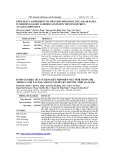
![Bài giảng kỹ thuật tưới nước hồ tiêu [chuẩn nhất]](https://cdn.tailieu.vn/images/document/thumbnail/2022/20221102/phuongduy205/135x160/4311667380119.jpg)
